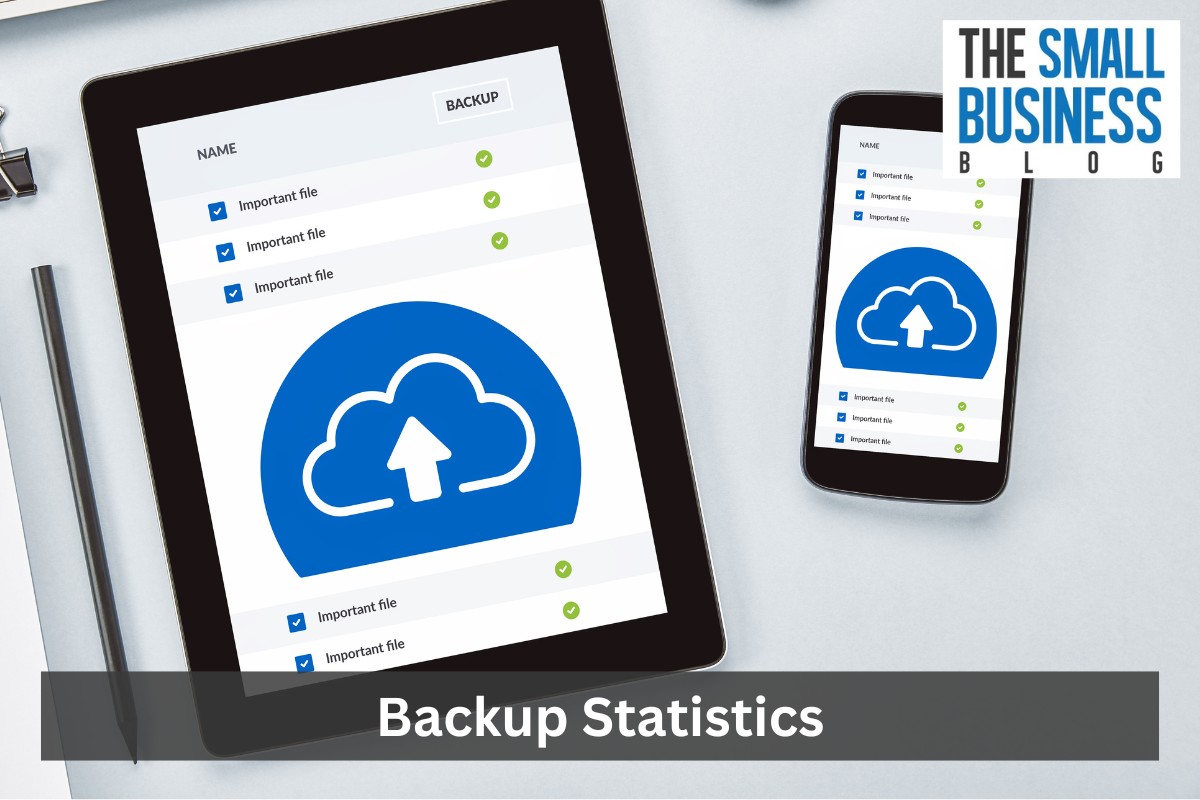A backup acts as a protective shield for your valuable digital belongings, guarding against unexpected data damage, deletion, or loss.
Data backup, in its most basic form, involves crafting a duplicate of your digital data and vital business information.
This mirrored version stands guard, poised to catch and restore your data in the face of unforeseen circumstances.
However, there’s more to explore beneath the surface – a collection of backup statistics that underline the urgency of implementing strong data protection strategies.
This article delves into Backup Statistics that highlight the cruciality of data backup and its various facets, shedding light on why businesses and individuals alike should pay heed to this simple yet powerful practice.
Here, we will identify the fundamental reasons why data backup is pivotal.
From the straightforward process to the strategic advantage of offsite backups, every aspect contributes to the narrative that safeguarding your digital realm is more than a choice – it’s a necessity.
Post Contents
- 1 Key Statistics
- 2 General Backup Statistics in 2024
- 3 Backup Failure Statistics
- 3.1 3. A substantial majority of companies (94%) fail to rebound from a severe data loss
- 3.2 4. 43% of data losses are due to hardware failures
- 3.3 5. Approximately 140,000 hard drive failures occur each week
- 3.4 6. Victims of ransomware lose a significant portion of their data, typically around 35%
- 3.5 7. 93% of businesses without an emergency backup plan close down within a year after a major loss of data
- 3.6 8. 40% of business owners are aware that there are over 10,000 sensitive files found in their company
- 3.7 9. 40% to 50% of small businesses require data recovery plans
- 3.8 10. As of 2020, hard drive failure rate stood at 0.93%
- 4 Backup Challenges Statistics
- 4.1 11. 95% of IT leaders believe that sensitive data faces unauthorized access andloss when transmitted via email
- 4.2 12. 2021 data reveals that 33% of all folders employed within companies remain accessible to everyone
- 4.3 13. About 20% of computer owners are still at risk of losing all of their data
- 4.4 14. The average cost of a data breach in the healthcare industry is $10.1 million
- 4.5 15. Drive recovery can be expensive and cost as high as $7,500
- 4.6 16. A hard drive’s longevity ranges from 5 to 10 years
- 4.7 17. Average expense of recovering data from a broken hard drive ranges between $100 and $2,000
- 4.8 18. Repairing a basic hard drive can incur expenses ranging from $100 to $700
- 4.9 19. The average person can generate 36GB worth of data
- 4.10 20. A substantial 54% of surveyed businesses solely rely on cloud backup storage
- 4.11 21. Business organizations can save up to $3.05 million with data backups using technologies like artificial intelligence (AI)
- 4.12 22. The starting cost for disaster recovery software typically begins at $10 per month
- 5 Conclusion
Key Statistics
- 30% of businesses experienced data loss due to no backups
- Healthcare breaches cost $10.1 million on average
- AI-backed backups can save up to $3.05 million
- 93% of unplanned data loss leads to business closure
- 20% of computer owners risk total data loss
- Hardware failures cause 43% of data loss
- 54% rely solely on cloud backups
General Backup Statistics in 2024

1. Approximately 22% of individuals and businesses choose to back up their data on a daily basis
The latest backup statistics show that a subset of diligent users recognizes the paramount importance of data and information continuity.
Approximately 22% of individuals and businesses prioritize their digital assets to the extent that they opt for daily backups.
This approach is a testament to their commitment to safeguarding their most recent changes and updates in near-real-time.
For these users, data loss is not an option, as their operations heavily depend on the constant availability of up-to-date information.
In sectors such as finance, healthcare, and technology, where even a minute’s worth of data could translate to significant implications, daily backups are a proactive measure against disruptions caused by hardware failures, cyber threats, or accidental deletions.
(Backblaze)
2. Around 30% of businesses have experienced data loss incidents due to the lack of backup practices
Recent studies show the prevalence of data loss incidents, revealing that approximately 30% of businesses have faced the detrimental aftermath of data loss at some juncture.
This staggering statistic serves as a resounding wake-up call to organizations worldwide, emphasizing the urgent need to fortify their data protection strategies.
Small businesses are not immune either, with around 58% admitting to being unprepared for data loss.
These businesses face a stark reality, as 60% of small companies that experience data loss go out of business within six months.
(IBM and Small Business Trends)
Backup Failure Statistics
3. A substantial majority of companies (94%) fail to rebound from a severe data loss
The repercussions of substantial data loss are deeply profound, shaping the destiny of enterprises.
Astonishingly, about 94% of companies grappling with severe data loss find themselves unable to regain their former footing.
The magnitude of this impact is often so grave that it spells the downfall of businesses.
This unfortunate trajectory is largely attributed to the extended period it takes—approximately 280 days or over nine months—to detect and mitigate a data breach.
(Truelist)
4. 43% of data losses are due to hardware failures
From mundane mishaps to unexpected challenges, the causes of data loss paint a diverse canvas, unveiling vulnerabilities that organizations must address.
At the forefront of prevalent data loss triggers, hardware failures claim the lead with a frequency of occurrence standing at 43%.
Whether it’s the result of external forces or internal missteps, data loss can have far-reaching consequences.
Data losses can stem from a variety of reasons:
- 43% of data losses are caused by hardware failures
- 30% of data losses are caused by human error
- 12% of data losses are caused by software corruption
- 7% of data losses are caused by computer viruses
- 5% of data losses are caused by theft
- 3% of data losses are caused by other reasons such as catastrophes causing physical computer damages
(R-explorer)
5. Approximately 140,000 hard drive failures occur each week
Within the borders of the United States, an estimated 140,000 instances of hard drive failure unfold on a weekly basis.
This frequency shows the pervasive challenges posed by hardware vulnerabilities, highlighting the need for crucial data backup strategies and proactive measures to secure critical information.
This is a reminder that data loss is not a remote possibility but a concrete risk that businesses and individuals must confront in the digital age.
The digital ecosystem, while enhancing efficiency and connectivity, also exposes us to the vulnerability of hardware breakdowns, making comprehensive data protection important.
(Tech Rockstars)
6. Victims of ransomware lose a significant portion of their data, typically around 35%

Within the world of cybersecurity, a concerning statistic highlights the outcomes of ransomware attacks.
It reveals that the average ransomware victim bears a substantial loss, amounting to an average of 35% of their data.
The implications of this data loss are both complex and far-reaching, demanding a closer examination of the outcomes faced by victims.
A data backup plan serves as a buffer against the uncertainties of ransomware attacks.
Organizations can minimize data loss by maintaining secure and up-to-date backup copies of critical information.
Vigilance and education remain essential in mitigating the risk of ransomware.
Organizations can strengthen their defenses by equipping employees with the knowledge to identify and respond to potential threats.
(Truelist)
7. 93% of businesses without an emergency backup plan close down within a year after a major loss of data
Unforeseen disasters can swiftly unravel even the most successful enterprises.
A statistic that highlights this vulnerability reveals that a staggering 93% of companies confronted with a substantial loss, and lacking a strategic emergency backup plan, find themselves shutting down within a mere year.
This profound figure resonates not only as a warning to small businesses but as a universal call for all enterprises to recognize the significant importance of data disaster recovery.
The implication is clear: without a comprehensive plan in place, the majority of companies face a daunting challenge to endure beyond a year following a catastrophic event.
(Enterprise Apps Today)
8. 40% of business owners are aware that there are over 10,000 sensitive files found in their company
Recent statistics reveal that 40% of businesses are aware of having more than 10,000 sensitive files within their corporate confines.
This revelation not only marks a pivotal aspect of the data protection record but also underscores the potential vulnerabilities arising from a surplus of accessible information.
From confidential client information to proprietary strategies, the digital landscape holds an array of data that demands protection.
However, the figure of 40% acknowledging the presence of over 10,000 sensitive files signals a need for heightened awareness.
As digital assets grow, so do the opportunities for unintended actions, such as accidental deletions, modifications, or unauthorized compromises of sensitive documents.
(Varonis)
9. 40% to 50% of small businesses require data recovery plans
Small businesses, often juggling limited resources and manpower, are not exempt from the imperative of safeguarding their digital assets.
With an alarming 40% to 50% of small businesses in need of data recovery plans, the role of preparedness takes on heightened significance.
Small businesses, despite their scale, are not immune to the wide array of threats that can compromise digital data.
From hardware failures to cyberattacks and human errors, the spectrum of potential data loss triggers is intimidating.
The absence of a structured data recovery plan leaves these enterprises susceptible to dire consequences that can encompass operational disruptions, financial strain, and reputational damage.
(Enterprise Apps Today)
10. As of 2020, hard drive failure rate stood at 0.93%
The 0.93% hard drive failure rate in 2020 is not an isolated problem.
It indicates the potential fragility of digital storage solutions, urging individuals and businesses to be proactive in backing up and protecting their data.
Hard drive failures can result from a range of factors, including mechanical issues, manufacturing defects, or even simple wear and tear.
Such occurrences can have far-reaching consequences, from disrupting daily operations to compromising sensitive information.
In light of this statistic, the implementation of robust data protection measures becomes really important.
Creating backup copies emerges as a fundamental practice.
(Backblaze)
Backup Challenges Statistics
11. 95% of IT leaders believe that sensitive data faces unauthorized access andloss when transmitted via email
Vulnerabilities often lurk within transmissions of data, posing crucial risks to sensitive information.
In modern business operations, data flows ceaselessly, weaving its threads through various communication channels and repositories.
A considerable 95% of IT leaders harbor concerns about the exposure of sensitive data to unauthorized access and potential loss when shared through email.
Meanwhile, 83% of organizations have endured data breaches stemming from email use.
(Invenioit)
12. 2021 data reveals that 33% of all folders employed within companies remain accessible to everyone
With a significant 33% of folders being entirely unprotected within companies in 2021, it becomes evident that comprehensive data protection is an indispensable aspect of modern business management.
This exhibits a glaring absence of protection has profound implications, as sensitive data remains vulnerable to unauthorized access.
It not only exposes the organization to compliance breaches but also puts its reputation and financial stability at risk.
(Comparitech)
13. About 20% of computer owners are still at risk of losing all of their data
Recent statistics have revealed that despite the advancements in data protection awareness and technology, about 20% of computer owners continue to operate without a safety net for their digital assets.
This reality exposes the pressing need for a renewed emphasis on data protection and backup practices, as well as a broader understanding of the potential consequences of such negligence.
In a 2022 survey, computer owners were asked how often they back up their data.
While the count of daily backups hasn’t yet reached the desired level, the data suggests that:
- 26% of computer owners back up their data less than once a year
- 20% of computer owners back up their data on a monthly basis
- 20% of computer owners never back up their data
- 13% of computer owners back up their data on a yearly basis
- 11% of computer owners back up their data on a weekly basis
- 10% of computer owners back up their data on a daily basis
(Backblaze)
14. The average cost of a data breach in the healthcare industry is $10.1 million
Due to the lack of backup practices, the risk of data loss is prevalent in many industries, although certain businesses face greater vulnerability than others.
From a financial perspective, industries subject to stringent regulations are particularly at risk due to the potential for fines and penalties.
The average cost of a data breach can vary widely across industries due to factors such as the type of data compromised, the size of the organization, the extent of the breach, and the regulatory environment.
Here are the approximate average costs of data breaches in certain industries based on historical data:
- $10.1 million worth of data breach cost is faced by the healthcare industry, governed by strict regulations like HIPAA
- $5.97 million breach worth of data breach cost is faced by regulated financial sectors, prone to ransomware
- $5.04 million worth of data breach cost is faced by pharmaceuticals, exposing 58% of executives’ credentials.
- $4.88 million worth of data breach cost is faced by tech companies
(Inventioit)
15. Drive recovery can be expensive and cost as high as $7,500

Drive recovery can exact a financial toll that varies widely.
With the potential costs soaring as high as $7,500, understanding the intricacies of data recovery expenses becomes essential in evaluating the value of preserving critical information.
The cost range for data recovery is broad and can start from a few hundred dollars to thousands.
Simple cases of accidental deletion or minor software corruption might entail relatively lower costs.
However, more complex scenarios, such as hardware failures or extensive data corruption, can escalate expenses considerably.
(Enterprise App Today)
16. A hard drive’s longevity ranges from 5 to 10 years
The lifespan of a hard drive typically ranges from 5 to 10 years.
This essential piece of hardware holds the key to preserving your digital data, making decisions about data backup important.
When it comes to protecting your information, the local vs. cloud backup debate is a common consideration, and understanding the nuances can help you make an informed choice.
Cloud storage is preferable for incremental backups due to its ample space, while physical storage is more suitable for extensive data, serving well for full and differential backups.
(Web Tribunal)
17. Average expense of recovering data from a broken hard drive ranges between $100 and $2,000
The average cost of retrieving data from a damaged hard drive ranges from $100 to $2,000.
This financial consideration can be substantial, presenting the importance of choosing a data recovery company that aligns with your specific needs.
Some companies employ a pricing model of $1 per gigabyte, which implies that recovering data from a 3TB drive could cost up to $3,000.
Simple data restoration, such as recovering a deleted file, might entail only a minimal investment, with professional data recovery services charging as little as $50 for a quick fix.
However, data loss statistics reveal that more severe cases, like physical damage to a hard drive or the corruption of crucial system files, demand a more substantial commitment of time and resources.
Complex scenarios of this nature might necessitate days or even weeks of meticulous work by skilled data recovery technicians.
(Truelist)
18. Repairing a basic hard drive can incur expenses ranging from $100 to $700
The average cost for hard drive recovery is subject to variation, contingent upon the severity of damage and the extent of data retrieval necessary.
Professional recovery services are typically billed at hourly rates, with complexities influencing the final cost.
In cases of a failing hard drive, the expenses could escalate significantly, with the average cost of $100 to $700, potentially reaching up to $1,000.
It’s imperative to consider these financial aspects when evaluating the feasibility of data recovery against the value of the lost data.
(Enterprise Apps Today)
19. The average person can generate 36GB worth of data
According to a survey in 2016, the average person can produce a monthly average of 36GB of data.
As data creation continues to surge, with growing file sizes, a significant 90% of individuals rely on local storage devices for housing their extensive data.
Despite its popularity for backup, local storage isn’t always the most efficient choice.
Cloud storage has emerged as a preferred option for businesses, primarily due to its ease in facilitating data migrations.
These evolving backup statistics underline the imperative of staying updated with contemporary data storage methods.
(Enterprise Apps Today)
20. A substantial 54% of surveyed businesses solely rely on cloud backup storage
The ascent of cloud storage as the preferred data backup solution is strikingly evident.
A substantial 54% of businesses, according to recent surveys, have embraced cloud backup storage as their exclusive means of preserving critical data.
To safeguard against data loss, businesses utilize various data backup methods, often opting for on-premises hardware or cloud-based services.
Recent research underscores the dominance of cloud storage:
- 54% of business organizations utilized cloud storage backup
- 33% of business organizations utilized local backup
- 12% of surveyed businesse organizations utilized hybrid backup, combining cloud and local storage
(Invenioit)
21. Business organizations can save up to $3.05 million with data backups using technologies like artificial intelligence (AI)

Data backups constitute a significant element within comprehensive strategies for business continuity and disaster recovery.
They wield the potential to reduce downtime and uphold regulatory compliance.
While the implementation of disaster recovery plans and consistent data backups does necessitate a financial commitment, the long-term benefits can translate into substantial cost savings.
Businesses that place a premium on disaster preparedness can reap financial advantages through the following avenues:
- An average cost of $3.05 million can be saved with innovative technologies like artificial intelligence (AI) and automation
- An average cost of $2.66 million can be saved using incident response teams that rigorously test recovery plans experience
- An average cost of $1.12 million can be saved with the containment of a data breach within 200 days
(Invenioit)
22. The starting cost for disaster recovery software typically begins at $10 per month
The charges in using disaster recovery software can fluctuate based on your preference for pricing models, be it per device or per user, as well as the amount of storage needed, among other factors.
While comprehensive solutions catering to extensive operations may incur higher costs, these remain reasonable when set side by side with the potential financial consequences of a breach event.
(Enterprise Apps Today)
Conclusion
In a world governed by digital interactions and data-driven operations, the importance of data backup emerges as a non-negotiable cornerstone of modern business continuity.
The Backup Statistics presented in this comprehensive exploration highlight the reality that data loss is not merely a possibility but a crucial and costly event that organizations must confront.
Whether it’s the prevalence of hardware failures, the potential devastation of ransomware attacks, or the vulnerability of sensitive data transmitted via email, the data shows that the risks are real, and the consequences can be severe.
As industries navigate an area where every digital interaction generates and stores valuable information, the need for robust protection strategies becomes critical.
The insights unveiled in this article are not just numbers; they are a clear call for enterprises to prioritize data backup, fortify their defenses, and ensure the continuity of their operations in an increasingly interconnected and data-dependent world.






























